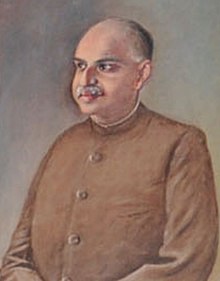The Akhil Bharatiya Jana Sangh (abbreviated as BJS or JS, short name: Jan Sangh,[9] was an Indian nationalist political party. This party was established on 21 October 1951 in Delhi, that existed from 1951 to 1977. Its three founding members were Shyama Prasad Mukherjee, Balraj Madhok and Deendayal Upadhyaya. Jan Sangh was the political arm of Rashtriya Swayamsevak Sangh (RSS), a Hindu nationalist volunteer organisation.[10] In 1977, it merged with several other left, centre and right parties opposed to the Indian National Congress and formed the Janata Party.[11] In 1980, the members of erstwhile Jan Sangh quit the Janata party after the defeat in the 1980 general elections and formed the Bharatiya Janata Party, which is the direct political successor to the Jan Sangh.
Bharatiya Jana Sangh | |
|---|---|
| President | Bharat Bhushan Pandey |
| Founder | Syama Prasad Mukherjee |
| Founded | 21 October 1951[1] |
| Dissolved | 23 June 1977 |
| Split from | All India Hindu Mahasabha |
| Merged into | Janata Party (1977–1980) |
| Succeeded by | Bharatiya Janata Party (1980–present) |
| Ideology | Hindu nationalism[2] Hindutva[3] Integral humanism[4] National conservatism[5] Economic nationalism[6] |
| Political position | Right-wing[7] |
| Religion | Hinduism[8] |
| Colours | Saffron |
| Election symbol | |
 | |
Origins

Many members of the right-wing Hindu nationalist Rashtriya Swayamsevak Sangh (RSS) began to contemplate the formation of a political party to continue their work, begun in the days of the British Raj, and take their ideology further. Around the same time, Syama Prasad Mukherjee left the Hindu Mahasabha political party that he had once led because of a disagreement with that party over permitting non-Hindu membership.[12][13][14] The BJS was subsequently started by Mukherjee on 21 October 1951[1] in Delhi, with the collaboration of the RSS, as a "nationalistic alternative" to the Congress Party.[15]
After the death of Mukherjee in 1953, RSS activists in the BJS edged out the career politicians and made it a political arm of the RSS and an integral part of the RSS family of organisations (Sangh Parivar).[16]
The strongest election performance of the BJS came in the 1967 Lok Sabha election in which it won 35 seats,[17][18] when the Congress majority was its thinnest ever.[19]
Ideology
The BJS leadership strongly supported a strong policy against Pakistan and China, and were averse to the Communist idelogy and the Soviet Union. Many BJS leaders also initiated the drive to ban cow slaughter nationwide in the early 1960s.[20]
Chronological list of presidents
| # | Portrait | Name | Term |
|---|---|---|---|
| 1 |  | Syama Prasad Mukherjee | 1951–52 |
| 2 | Mauli Chandra Sharma | 1954 | |
| 3 | Prem Nath Dogra | 1955 | |
| 4 | Debaprasad Ghosh | 1956–59 | |
| 5 | Pitamber Das | 1960 | |
| 6 | Avasarala Rama Rao | 1961 | |
| (4) | Debaprasad Ghosh | 1962 | |
| 7 | Raghu Vira | 1963 | |
| (4) | Debaprasad Ghosh | 1964 | |
| 8 | Bachhraj Vyas | 1965 | |
| 9 | Balraj Madhok | 1966 | |
| 10 | Deendayal Upadhyaya | 1967–68 | |
| 11 |  | Atal Bihari Vajpayee | 1968–72 |
| 12 |  | L. K. Advani | 1973–77 |
| See List of presidents of the Bharatiya Janata Party | |||
In general elections
The Bharatiya Jana Sangh was created in 1951, and the first general election it contested was in 1951–52, in which it won only three Lok Sabha seats, in line with the four seats won by Hindu Mahasabha and three seats won by Ram Rajya Parishad. Shyama Prasad Mookerjee and Durga Charan Banerjee were elected from Bengal and Uma Shankar Trivedi from Rajasthan. All the like-minded parties formed a block in the Parliament, led by Shyama Prasad Mookerjee.[21][17]
| Year | General Election | Seats Won | Change in Seat | % of votes | Ref. |
|---|---|---|---|---|---|
| 1951 | 1st Lok Sabha | 3 | – | 3.06 | [21][18] |
| 1957 | 2nd Lok Sabha | 4 |  1 1 | 5.93 | [17][18] |
| 1962 | 3rd Lok Sabha | 14 |  10 10 | 6.44 | [17][18] |
| 1967 | 4th Lok Sabha | 35 |  21 21 | 9.31 | [17][18] |
| 1971 | 5th Lok Sabha | 22 |  13 13 | 7.35 | [22][18][23] |
References
Sources
- Andersen, Walter K.; Damle, Shridhar D. (1987) [Oringally published by Westview Press]. The Brotherhood in Saffron: The Rashtriya Swayamsevak Sangh and Hindu Revivalism. Delhi: Vistaar Publications.
- Islam, Shamsul (2006b). Savarkar Myths and Facts. Anamaika Publishing & Distributors.
- Kumar, Kedar Nath (1990). Political Parties in India, Their Ideology and Organisation. Mittal Publications. ISBN 9788170992059.
- Nag, Kingshuk (2014). The Saffron Tide: The Rise of the BJP. Rupa Publications. ISBN 978-8129134295.
- Sharma, Urmila; Sharma, S.K. (2001). Indian Political Thought. Atlantic Publishers & Distributors. ISBN 9788171566785.
Further reading
- Baxter, Craig (1971) [first published by University of Pennsylvania Press 1969]. The Jana Sangh – A Biography of an Indian Political Party. Oxford University Press, Bombay. ISBN 0812275837.
- Graham, B. D. (1990). Hindu Nationalism and Indian Politics: The Origins and Development of the Bharatiya Jana Sangh. Cambridge University Press. ISBN 0-521-38348X.
- Jaffrelot, Christophe (1996). The Hindu Nationalist Movement and Indian Politics. C. Hurst & Co. Publishers. ISBN 978-1850653011.